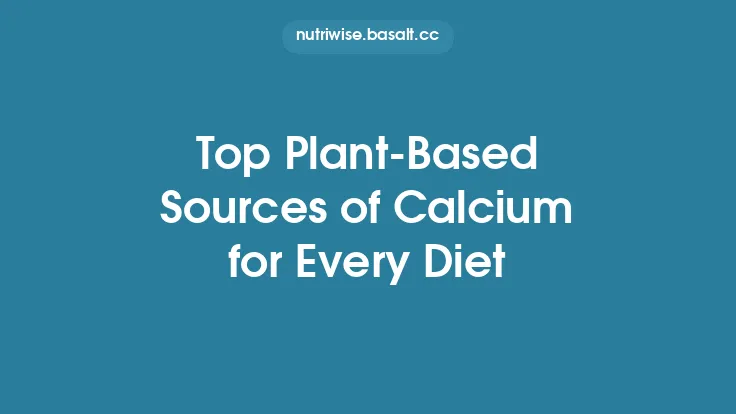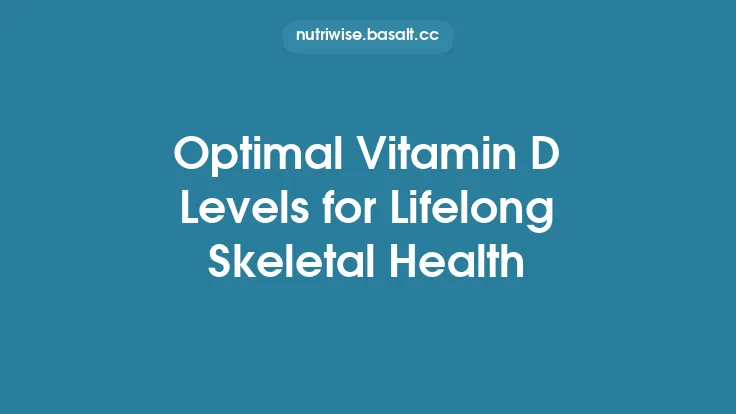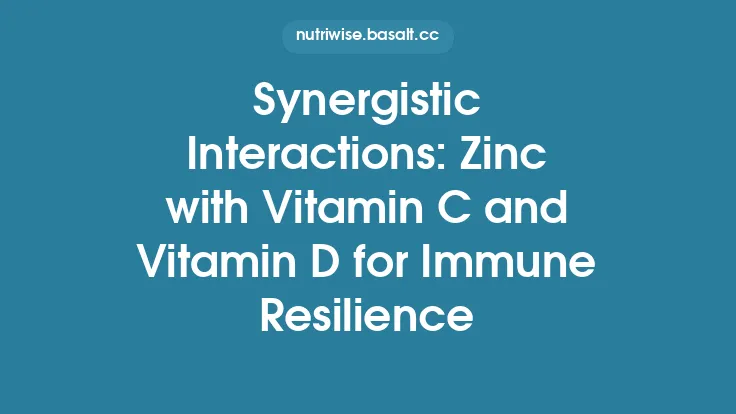Vitamin D is a fat‑soluble micronutrient that plays a pivotal role in calcium homeostasis and the mineralization of the skeletal matrix. While sunlight‑driven synthesis accounts for a substantial portion of the body’s vitamin D pool, dietary intake remains essential—particularly for individuals with limited sun exposure, higher melanin levels, older age, or lifestyle constraints that reduce cutaneous production. A well‑balanced diet that includes reliable sources of vitamin D can help maintain optimal serum concentrations, support bone remodeling, and reduce the risk of osteomalacia, osteoporosis, and related fractures.
Natural Food Sources Rich in Vitamin D
| Food Category | Representative Foods | Typical Vitamin D Content* (IU per 100 g) |
|---|---|---|
| Fatty Fish | Atlantic salmon, mackerel, sardines, herring, trout | 350–600 |
| Fish Liver Oils | Cod liver oil, halibut liver oil | 400–1,000 |
| Shellfish | Oysters, mussels, shrimp | 30–70 |
| Egg Yolks | Free‑range chicken eggs | 20–30 |
| Beef Liver | Grass‑fed beef liver | 15–20 |
| Wild‑foraged Mushrooms (UV‑exposed) | Shiitake, maitake, portobello (post‑UV) | 200–400 |
| Fortified Dairy | Whole milk, yogurt, cheese (U.S./EU fortified) | 40–120 |
| Fortified Plant Milks | Soy, almond, oat, rice milks (fortified) | 80–120 |
| Fortified Breakfast Cereals | Whole‑grain cereals (fortified) | 40–100 |
| Fortified Orange Juice | Vitamin D‑fortified 100 % juice | 80–100 |
\*Values are approximate and can vary based on species, farming practices, processing, and fortification levels. IU = International Units; 1 µg = 40 IU.
Fatty Fish: The Gold Standard
Marine species that inhabit cold, high‑latitude waters accumulate high concentrations of vitamin D₃ (cholecalciferol) in their muscle and adipose tissues. The lipid matrix of these fish protects the vitamin from oxidative degradation, making them the most bioavailable dietary source. A 100‑g serving of wild‑caught Atlantic salmon typically delivers 450 IU, covering roughly 56 % of the Recommended Dietary Allowance (RDA) for adults (800 IU for ages 19–70, 800–1,000 IU for older adults, per the Institute of Medicine).
Fish Liver Oils: Concentrated Powerhouses
Cod liver oil is a traditional remedy rich in both vitamin D₃ and vitamin A. A single teaspoon (≈5 mL) can provide up to 1,000 IU of vitamin D, but the high vitamin A content necessitates cautious use, especially in pregnancy. Modern formulations often standardize vitamin D content while reducing vitamin A to safe levels.
UV‑Exposed Mushrooms: The Plant‑Based Alternative
Mushrooms synthesize vitamin D₂ (ergocalciferol) when their cell walls are exposed to ultraviolet B (UV‑B) radiation. Unlike most plant foods, which contain negligible vitamin D, UV‑treated mushrooms can rival the vitamin D content of fortified dairy. The conversion efficiency depends on species, exposure duration, and post‑harvest handling. For vegans and vegetarians, incorporating 100 g of UV‑treated portobello mushrooms can contribute 300–400 IU of vitamin D₂.
Fortification: Bridging the Nutrient Gap
Because natural food sources are limited in many dietary patterns, fortification has become a public‑health strategy to improve population vitamin D status. Fortified products are engineered to contain stable forms of vitamin D₃ (or D₂) that survive pasteurization, homogenization, and shelf‑life.
- Dairy Fortification: In the United States, fluid milk is commonly fortified with 100 IU per cup (≈240 mL). European regulations often require 400 IU per liter. The presence of dietary fat in milk enhances the absorption of the fat‑soluble vitamin.
- Plant‑Based Milk Alternatives: Manufacturers add vitamin D₃ derived from lanolin or vitamin D₂ from lichen, depending on vegan certification. The fortification level is typically matched to that of cow’s milk to provide parity for consumers avoiding animal products.
- Cereals and Breads: Fortified breakfast cereals often contain 40–100 IU per serving, and some whole‑grain breads are enriched during dough mixing. The presence of dietary fiber can modestly impede absorption, but the overall contribution remains valuable.
- Juices: Vitamin D‑fortified orange juice offers a convenient source for individuals who do not consume dairy. The acidic environment does not degrade vitamin D, preserving its potency.
When selecting fortified foods, verify the label for the specific form (D₃ vs. D₂) and the exact IU content per serving, as regulations and industry practices differ across regions.
Bioavailability Factors Influencing Dietary Vitamin D
The absorption of vitamin D from food is a multistep process that can be modulated by dietary composition, gastrointestinal health, and individual physiology.
- Dietary Fat: As a lipophilic molecule, vitamin D requires micellar solubilization in the presence of bile salts. Consuming vitamin D‑rich foods with at least 5–10 g of fat (e.g., a drizzle of olive oil, full‑fat dairy, or fatty fish) markedly improves uptake.
- Meal Timing and Composition: Co‑ingestion with a mixed macronutrient meal (carbohydrate + protein + fat) yields higher postprandial serum vitamin D levels than isolated intake on an empty stomach.
- Gut Microbiota: Emerging evidence suggests that certain bacterial taxa influence bile acid metabolism, indirectly affecting vitamin D micelle formation. Dysbiosis may therefore reduce absorption efficiency.
- Age‑Related Changes: Elderly individuals often experience reduced bile production and pancreatic enzyme secretion, necessitating higher dietary fat intake to achieve comparable absorption.
- Genetic Polymorphisms: Variants in the *GC gene (vitamin D‑binding protein) and CYP2R1* (25‑hydroxylase) can alter circulating vitamin D concentrations despite similar intake, underscoring the need for personalized nutrition strategies.
Integrating Vitamin D‑Rich Foods into Everyday Meals
Breakfast
- Fortified Oat Milk Smoothie: Blend 250 mL fortified oat milk (≈100 IU) with frozen berries, a tablespoon of ground flaxseed, and a scoop of whey or plant protein. Add a handful of UV‑treated mushrooms for an extra 150 IU.
- Egg‑Based Omelet: Two free‑range eggs (≈50 IU) cooked in butter, filled with sautéed spinach and smoked salmon (≈150 IU per 50 g). Serve with a slice of whole‑grain toast.
Lunch
- Mackerel Salad: Grilled Atlantic mackerel (120 g, ≈500 IU) atop mixed greens, cherry tomatoes, avocado, and a vinaigrette made with olive oil. The avocado contributes healthy monounsaturated fats that aid vitamin D absorption.
- Mushroom‑Fortified Soup: A pureed cauliflower and UV‑treated mushroom soup, enriched with a splash of fortified soy milk (≈80 IU). Pair with a side of fortified whole‑grain crackers.
Dinner
- Baked Salmon with Quinoa: 150 g wild‑caught salmon (≈675 IU) baked with lemon and herbs, served over quinoa tossed with roasted vegetables drizzled in olive oil.
- Stir‑Fry with Cod Liver Oil: A quick stir‑fry of broccoli, bell peppers, and tofu, finished with a teaspoon of cod liver oil (≈400 IU) for a potent vitamin D boost.
Snacks
- Yogurt Parfait: Greek yogurt fortified with vitamin D (≈80 IU per 150 g) layered with granola and fresh fruit.
- Fortified Cereal Bar: A portable bar containing 40 IU of vitamin D, ideal for on‑the‑go consumption.
Special Considerations for Dietary Patterns
Vegetarian and Vegan Diets
- Primary Sources: UV‑treated mushrooms, fortified plant milks, fortified orange juice, and algae‑derived vitamin D₃ supplements (if supplementation is later deemed necessary).
- Nutrient Synergy: Pair vitamin D‑rich foods with calcium‑rich plant sources (e.g., fortified tofu, kale, bok choy) to support bone mineralization.
Lactose‑Intolerant Individuals
- Opt for lactose‑free fortified dairy alternatives (e.g., lactose‑free milk, kefir) or fortified soy yogurt. The presence of calcium and vitamin D in the same matrix enhances skeletal benefits.
Low‑Fat Diets
- While low‑fat regimens may limit the natural absorption of vitamin D, incorporating modest amounts of healthy fats (e.g., nuts, seeds, avocado) at each vitamin D‑containing meal can offset this limitation without compromising overall caloric goals.
Cultural and Regional Variations
- Nordic Countries: Frequent consumption of herring, gravlax, and cod liver oil aligns with traditional high vitamin D intakes.
- East Asian Diets: Incorporation of UV‑treated shiitake mushrooms and fortified soy products provides a culturally appropriate source.
- Mediterranean Diet: Emphasis on oily fish (sardines, anchovies) and fortified dairy aligns with the region’s culinary patterns.
Monitoring Dietary Vitamin D Intake
- Food Diaries: Track servings of vitamin D‑rich foods over a 7‑day period. Use nutrition analysis software to calculate total IU intake.
- Label Literacy: Look for “IU per serving” and note whether the product contains vitamin D₃ or D₂. D₃ generally exhibits higher potency in raising serum 25‑hydroxyvitamin D levels.
- Seasonal Adjustments: During winter months, when sunlight exposure wanes, increase the frequency of fortified foods or fatty fish to maintain consistent intake.
- Professional Guidance: Registered dietitians can tailor meal plans based on individual health status, dietary restrictions, and laboratory results.
Practical Tips for Maximizing Vitamin D from Food
- Cook with Fat: Sauté mushrooms in a teaspoon of olive oil or butter to improve vitamin D₂ extraction.
- Avoid Over‑Processing: Excessive heating can degrade vitamin D, especially in fortified dairy. Heat fortified milk gently (≤70 °C) and avoid prolonged boiling.
- Store Properly: Vitamin D is relatively stable but can oxidize when exposed to light and air. Keep fortified products in opaque containers and consume within the “best‑by” date.
- Combine with Calcium: A balanced calcium‑to‑vitamin D ratio (approximately 2:1 by weight) supports optimal bone remodeling. Pair a serving of salmon with a calcium‑rich side such as fortified tofu or low‑fat cheese.
Concluding Perspective
A diet thoughtfully composed of natural and fortified vitamin D sources offers a reliable, sustainable pathway to support skeletal health across the lifespan. By prioritizing fatty fish, UV‑treated mushrooms, fortified dairy or plant alternatives, and strategically pairing these foods with healthy fats and calcium‑rich companions, individuals can consistently meet or exceed the recommended intake without reliance on supplementation. Continuous attention to food selection, preparation methods, and personal dietary patterns ensures that vitamin D remains an accessible cornerstone of bone‑preserving nutrition.





